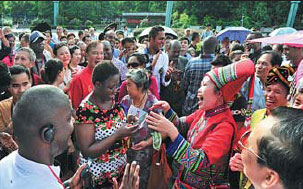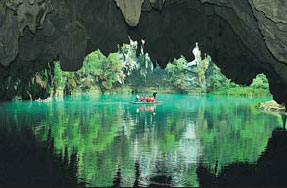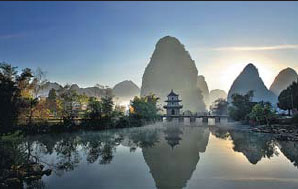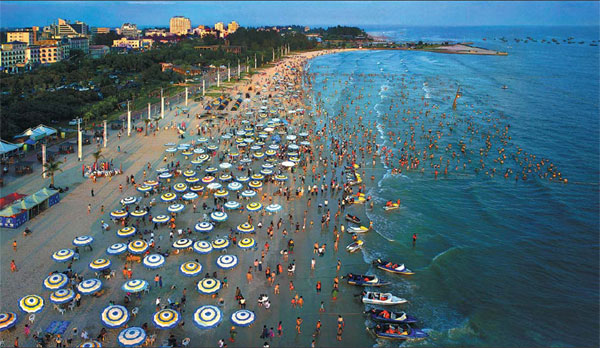Guangxi aims to be pathway to asean
Region is playing important role in China's overseas trade cooperation strategy, Hao Nan reports.
Guangxi Zhuang autonomous region has become an important gateway in China's opening up strategy and trade cooperation with the Association of Southeast Asian Nations, thanks to a number of development opportunities created during the 12th Five-Year Plan period (2011-15).
In 2011, for example, plans were discussed to develop the region as a role model of cooperation between China and ASEAN. In 2013, the State Council approved construction of a comprehensive border financial reform pilot zone in the region, and in 2014, development of the Pearl River-Xijiang River Economic Belt was upgraded to a national strategy.
In March 2015, President Xi Jinping said that to strategically reposition itself and aid its future development, Guangxi should become an international pathway to ASEAN countries, a new strategic pivot in Southwest and Central China's opening up strategy, and a dynamic portal connecting the 21st Century Maritime Silk Road and the Silk Road Economic Belt.
The local government has taken a number of steps to realize these goals.
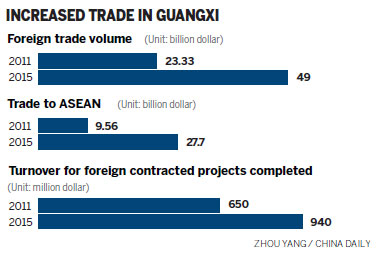
In 2015, it upgraded the Beibu Gulf economic area, carrying out 256 major projects in the fields of infrastructure construction, industry transformation and port logistics.
A special fund was arranged to develop the Xijiang River into a "golden waterway" to the Pearl River Delta, Hong Kong and Macao.
During the 2011-15 period, Guangxi accelerated subregional economic cooperation with the Pan-Beibu Gulf Zone and the Greater Mekong Subregion, speeded up construction of the Nanning-Singapore Economic Corridor and took part in negotiations on the proposed Regional Comprehensive Economic Partnership between China, ASEAN and other partners.
Guangxi now has an annual cargo handling capacity of more than 200 million metric tons in its Beibu Gulf sea ports and has established a China-ASEAN port cities network. It has opened air routes to major ASEAN cities and finished construction of the Nanning-Pingxiang high-speed road, the Guangxi sector of China's first expressway to Southeast Asia.
Since 2013, the region has accelerated infrastructure construction in ports along its borders, putting 55 projects on its agenda with total investment of over 230 million yuan ($35 million).
Guangxi has 25 dry, sea and river ports, including 19 national first-level open ports. Fangchenggang has navigable channels with more than 250 ports in over 100 countries and regions, and Qinzhou Port opened five direct trade routes to Hong Kong, Taiwan, Vietnam, Thailand and Singapore.
An increasing number of Guangxi companies tapped into overseas markets from 2011 to 2015.
By the end of 2014, nearly 570 local enterprises had gone global and most of them invested in ASEAN, covering a broad range of major industries including agriculture, mining, chemicals and communication equipment.
Guangxi International Construction Engineering Co, for instance, set up branches in Myanmar, Thailand, Vietnam, Cambodia and East Timor.
In 2014, the company signed overseas contracts worth $130 million.
During the first 10 months of 2015, Guangxi invested $161 million in ASEAN countries, 10 times more than in the same period in 2014.
The region launched a project in November 2014 to simplify the procedures for customs clearance to facilitate cross-border trade.
Through its participation in the Belt and Road Initiative, Guangxi has witnessed sustainable growth in foreign trade and overseas investment in recent years.
Its total imports and exports trade volume rose from $23.33 billion in 2011 to $49 billion in 2015, of which trade with ASEAN rose from $9.56 billion to $27.7 billion.
From January to October last year, Guangxi's foreign trade hit 221.1 billion yuan, of which 110.7 billion yuan was with ASEAN.
From 2011 to 2014, investment from Guangxi companies in foreign countries rose at an annual rate of 62 percent, increasing from $400 million to $2.12 billion.
During the 12th Five-Year Plan period, Guangxi enhanced communications between young people in the region and those in ASEAN through cultural exchanges.
Last year, the first China-ASEAN Expo Tourism Exhibition was held in Guilin, attracting some 800 global enterprises, 300 foreign professional buyers and nearly 150,000 participants.
Contact the writer at haonan@chinadaily.com.cn
Thriving tourism
Located in the southern part of China, Guangxi Zhuang autonomous region is famous for its natural scenery of karst land forms, which are stunning geological features created on the Earth's surface by water draining into the ground.
The Beibu Gulf Economic Zone in the south of the region has islands, beaches and waterfalls, making it a beautiful and tranquil spot for holidaymakers.
Natural beauty
In 2013, the National Development and Reform Commission of China released a strategy to build Guilin into an international tourist destination.
The plan bids to develop Guilin as a world-class tourist destination as well as a platform for international tourism cooperation and culture exchanges by 2020.
Guilin, with its stunning Lijiang River, which originates in the city's Maoer Mountain, is a beautiful place that attracts numerous tourists from all over the world.
The city was visited by Queen Margrethe II of Denmark in 1979 and Bill and Hillary Clinton in 1998, all of whom extolled its wonders.
Ethnic culture
The local Zhuang people have a rich tradition of both written and unwritten folk stories, which often take the form of songs. The third day of the March in the lunar calendar is their traditional folk song festival, called San Yue San (Third Month's Third Day).
Every year, Zhuang people, along with the local Han, Yao, Miao and Dong peoples, gather together to sing folk songs and play folk games.
The festival is marked by a four-day holiday throughout Guangxi, giving tourists a wonderful opportunity to experience local culture and color.
There are many stories about the origin of the event, but one of most popular features Liu Sanjie, the singing goddess of Zhuang legend.
Liu Sanjie became hugely popular among ordinary people by fighting the practices of oppressive landlords through her songs. It is said that the festival commemorates the day of her death.
Leisure
Guangxi is also a great place for tourists who value rest, relaxation and, perhaps, longevity.
Located in the northwest part of the region, covering 16,177 square kilometers, Bama county is reputed to have 74 residents who are over 100 years old and 531 in their 90s out of a population of only 238,000.
With Bama as the centerpiece, an international tourist zone was built covering karst caves, mountains, rivers and traditional villages.
By the end of 2014, there were five 4A level scenery spots, four 3As and two 2As in the zone.
Tours
The mountains surrounding Yangshuo county have been hailed as a climbers' paradise, and several climbing routes of varying difficult levels have been approved by expert climbers.
Starting from the cities of Beihai and Fangchenggang, tourists can travel on cruise ships across Ha Long Bay to Hanoi, Vietnam's capital city, where Ba Dinh Square, Ho Chi Minh Mausoleum and One Pillar Pagoda are all worth visiting.
|
Foreign visitors learn to sing folk songs of the Zhuang people in Guangxi. |
|
Underground river in Bama village in Guangxi is a hidden treasure for local residents. |
|
Karst landform in Jingxi city offers tourists spectacular natural views. |
|
Silver Beach in Beihai, Guangxi Zhuang autonomous region, is popular with both foreign and domestic tourists because of its pleasant environment. Photos Provided To China Daily |
(China Daily 05/27/2016 page22)
